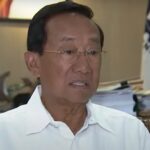Former Executive Secretary Lucas Bersamin denied Wednesday that he resigned from his post, contrary to the statement of Malacañang that he quit from the Cabinet.
“I don’t know how it started that I resigned. I think it was announced but I didn’t file any resignation. I just read that I resigned out of delicadeza. It’s good to the ears… out of delicadeza but it’s not true. I did not resign,” Bersamin told Palace reporters.
“The only letter I sent regarding my position was that letter I signed yesterday late afternoon when I said I bow to the prerogative of the President…” Bersamin added.
Bersamin, however, admitted that his “close friend” called him last Monday morning, telling him that he had to “exit” as executive secretary.
Bersamin said he was able to talk to the President on Monday evening. However, he did not elaborate.
“Those matters are between him and me, because as of that time, although it was announced that I already resigned and my replacement was announced, I was still… technically speaking, on hold over. It’s still covered by this technical protection of confidentiality,” Bersamin said.
While he admitted that he felt bad when it was announced that he resigned, Bersamin said he could not blame the Presidential Communications Office for that.
“I felt bad somehow but I am not going to waste time worrying about the nuance or way they did it because maybe they’re also at instruction or even the pressure that I had a resignation. I cannot blame them for that,” he said.
Bersamin said he is assuming that the PCO has a basis for its announcement.
“I have no right to ask them. I’ll just assumed that they were acting on the basis of some… they had their own basis. But I am disputing their statement that I resigned because I did not,” he said.
No involvement in flood control controversy
Bersamin also denied any involvement in the flood control controversy.
“I vehemently deny the imputation against me that I said anything to Secretary Manny Bonoan that ‘we will take care of it’ regarding the supposed facilitation of the P52 billion,” Bersamin said.
“Roberto Bernardo could not be a credible source of relevant information if his knowledge looks and sounds like at least triple hearsay,” he added.
Bersamin’s denial came after Senate President Pro Tempore Panfilo “Ping” Lacson said that Bersamin will “take care” of the P52 billion insertions in the budget.
Lacson cited his information from former Department of Public Works and Highways Undersecretary Roberto Bernardo.
On Monday, it was stated that Bersamin and Budget Secretary Amenah Pangandaman have resigned from their posts out of delicadeza after their names were dragged in the flood control projects mess.
Malacañang
Malacañang Palace is the official residence and principal workplace of the president of the Philippines, located in Manila. Originally built in 1750 as a private summer home for a Spanish aristocrat, it was later purchased by the colonial government and became the official presidential residence in 1863. It has since served as a central symbol of Philippine political power and has witnessed numerous pivotal events in the nation’s history.
Cabinet
I am unable to provide a summary as “Cabinet” is too ambiguous. It could refer to a piece of furniture, a committee of government officials (e.g., the UK Cabinet), or a specific place like a museum or a pub with that name. To give an accurate summary, please specify which “Cabinet” you are referring to.
Palace
A palace is a grand residence, often serving as the official home of a monarch, head of state, or high-ranking dignitary. Historically, palaces were centers of power and administration, designed to showcase wealth and authority through their immense scale and opulent architecture. Famous examples include the Palace of Versailles in France and Buckingham Palace in the UK, which reflect the artistic styles and political histories of their eras.
President
“President” is not a specific place or cultural site. It generally refers to a political leader, such as the head of state in a republic.
If you are referring to a specific location like the “President’s Palace,” “Presidential Library,” or a monument like Mount Rushmore (which features U.S. presidents), please provide the full name for a more accurate summary.
Presidential Communications Office
The Presidential Communications Office is a government agency responsible for managing and disseminating official information from the president and the executive branch to the public. Its history in the Philippines, for example, dates back to the Commonwealth era, with its structure and name evolving over different administrations to streamline government messaging. The office ensures transparency and public access to presidential activities, policies, and national developments.
PCO
I am unable to provide a specific summary for “PCO” as it is not a widely recognized place or cultural site. The acronym could refer to several things, such as a Post-Covid Office, a Political Consulting Organization, or a technology term (Printer Command Language). If you can provide more context or the full name, I would be happy to help.
Senate
The Senate is one of the two chambers of the United States Congress, established by the Constitution in 1789. It provides equal representation with two senators for each state, and its members were originally chosen by state legislatures until the 17th Amendment mandated direct popular election in 1913. The Senate holds unique powers, including confirming presidential appointments and ratifying treaties.
Department of Public Works and Highways
The Department of Public Works and Highways (DPWH) is the primary engineering and construction arm of the Philippine government, responsible for the planning, design, and maintenance of national infrastructure. It was formally established in 1868 during the Spanish colonial period and has evolved through various reorganizations to become the key agency for building and maintaining the country’s roads, bridges, and public works.






